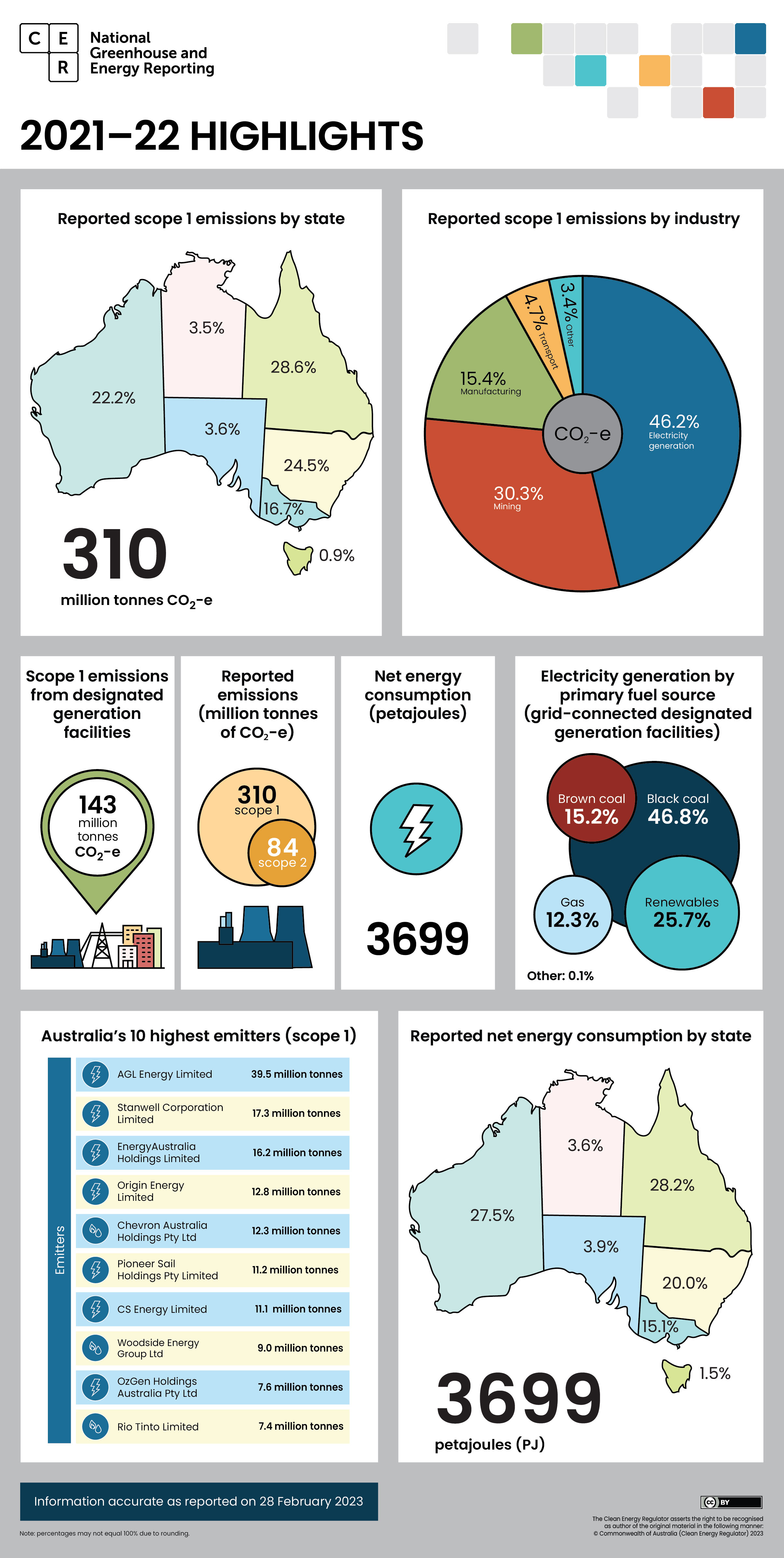On 28 February 2023, the Clean Energy Regulator (CER) published the annual National Greenhouse and Energy Reporting (NGER) data for the 2021-22 reporting year.
For the 2021-22 year, corporations reported a total of:
- 310 million tonnes of direct (scope 1) greenhouse gas emissions (carbon dioxide equivalence)
- 84 million tonnes of indirect (scope 2) greenhouse gas emissions (carbon dioxide equivalence)
- 3,699 petajoules net energy consumed
Data highlights
Highlights in the 2021-22 data (in comparison to last year’s data) include:
- The total reported scope 1 emissions declined by 1.6% or 5.1 million tonnes.
- This decline is mostly due to a decrease in emissions from electricity generation.
- Emissions in the electricity sector decreased by 4.6% or 6.8 million tonnes.
- This reduction is mostly due to the increased use of renewable energy (such as solar generation) and the decreased use of black coal.
- Emissions from oil and gas and LNG increased by 7.8% or 3.3 million tonnes.
- This increase is largely due to venting from increased production of LNG reflecting growing demand for this commodity.
- Emissions from coal mining decreased by 7.3% or 2.5 million tonnes.
- This reduction is mostly due to a reduction in emissions from underground coal mining.
2021-22 datasets
Datasets published for the 2021-22 reporting year include:
- Corporate emissions and energy data 2021-22
- Reporting transfer certificates holders 2021-22
- Electricity sector emissions and generation data 2021-22
- Extract of the National Greenhouse and Energy Register 2021-22
Visit what data is published and why for more information.
2021-22 published data spotlights
The following spotlights focus on key data released as part of the 2021-22 data publication:
- Australia’s 10 highest greenhouse gas emitters 2021-22
- State and territory emissions profile 2021-22
- Australia’s largest electricity generators 2021-22
- Electricity generation sector emissions reported over time 2019-22
Notes for the 2021-22 publication
- Industry groupings are based on the Australian and New Zealand Standard Industrial Classification (ANZSIC) codes reported for each facility.
- ‘Mining and Manufacturing’ aligns with the ANZSIC divisions B - Mining, and C - Manufacturing respectively.
- ‘Transport’ includes the ANZSIC subdivisions Road, Rail, Water, Air and Space and Other Transport.
- Fuel source ‘Gas’ includes fuel types Gas, Waste Coal Mine Gas and Coal Seam Methane. Fuel source ‘Renewables’ includes Solar, Wind, Hydro, Landfill Gas, Biofuel, Bagasse and Biogas. Fuel source ‘Other’ includes Diesel, Kerosene and Battery fuel types. These are based the primary fuel consumed by a facility to generate electricity in a year, as published in the designated generation facilities report.
- ‘Electricity generation’ only includes ANZSIC group 261. Electricity Distribution and Transmission (ANZSIC 262 and 263 respectively) are included in ‘other’.









